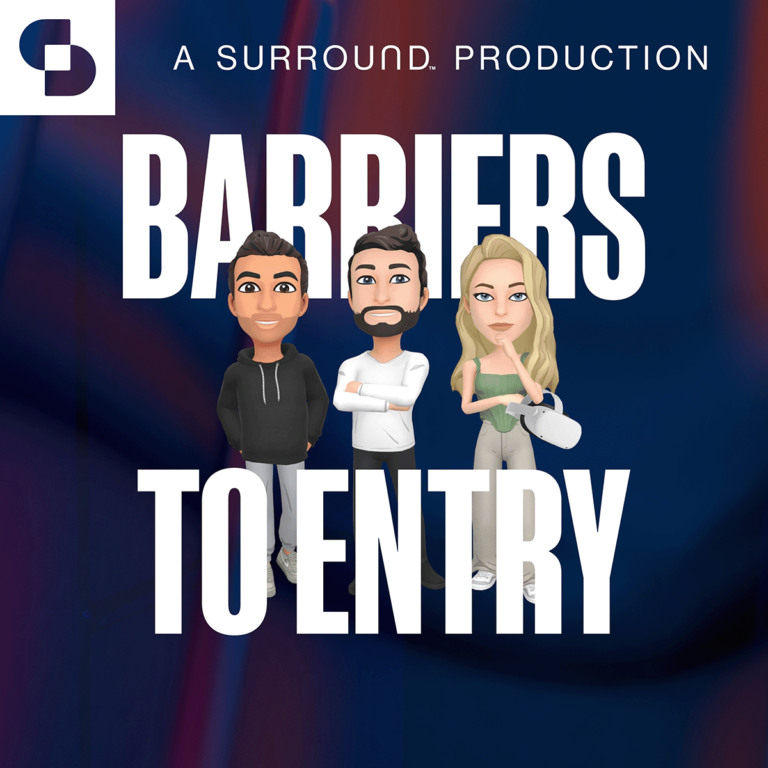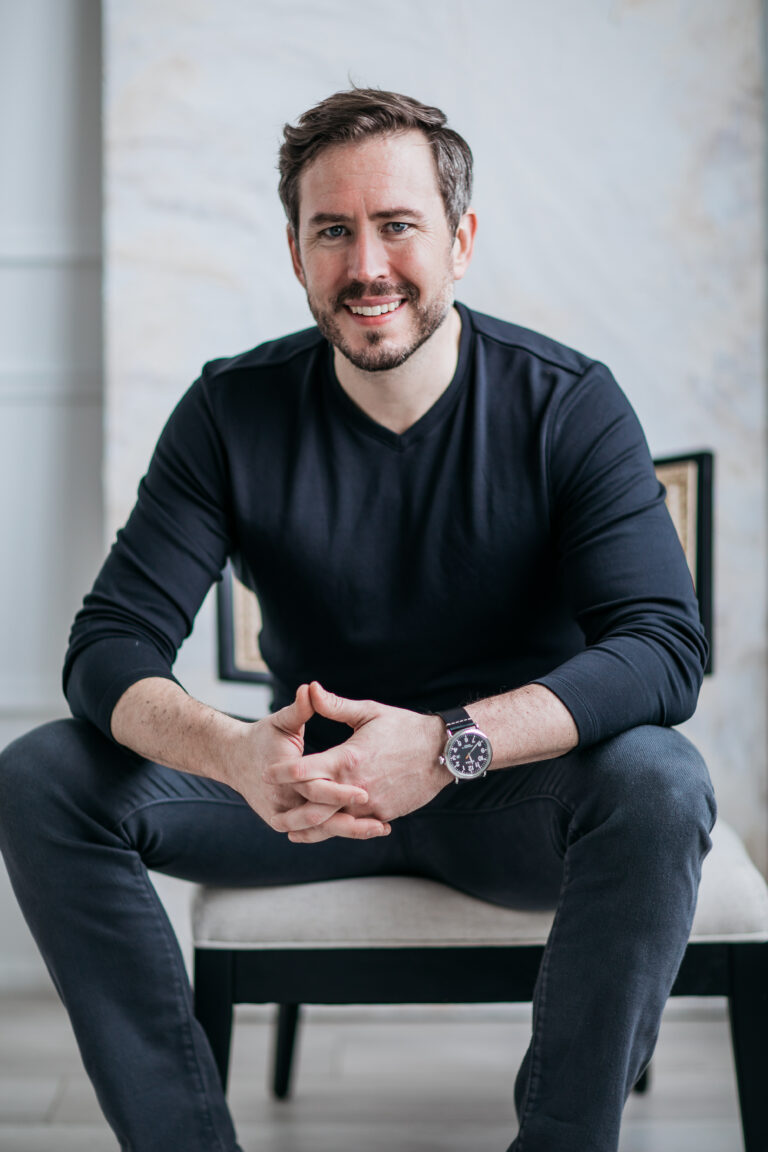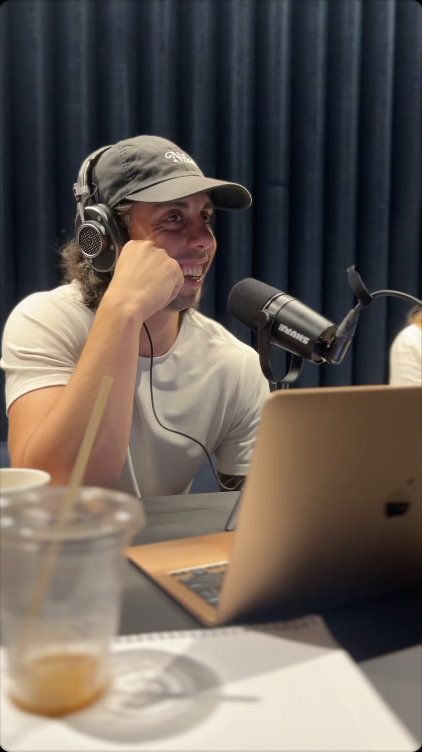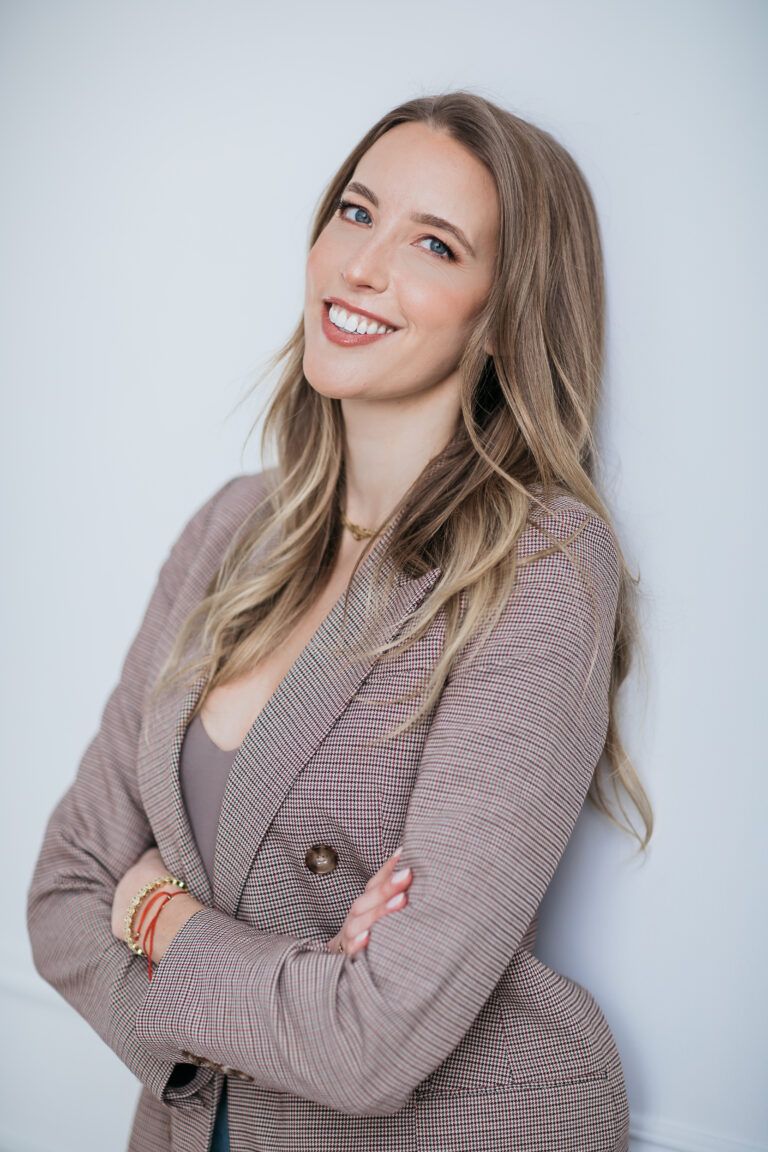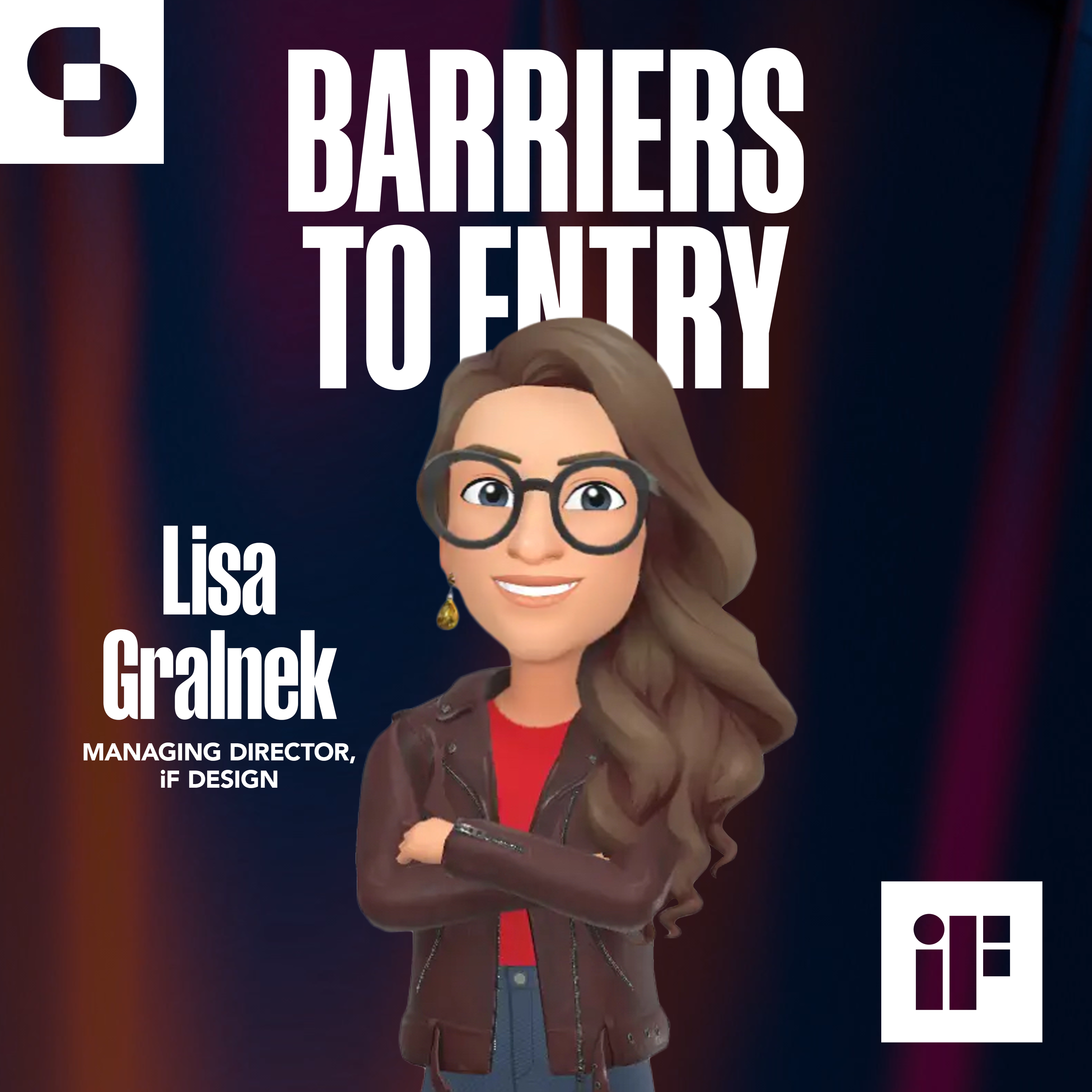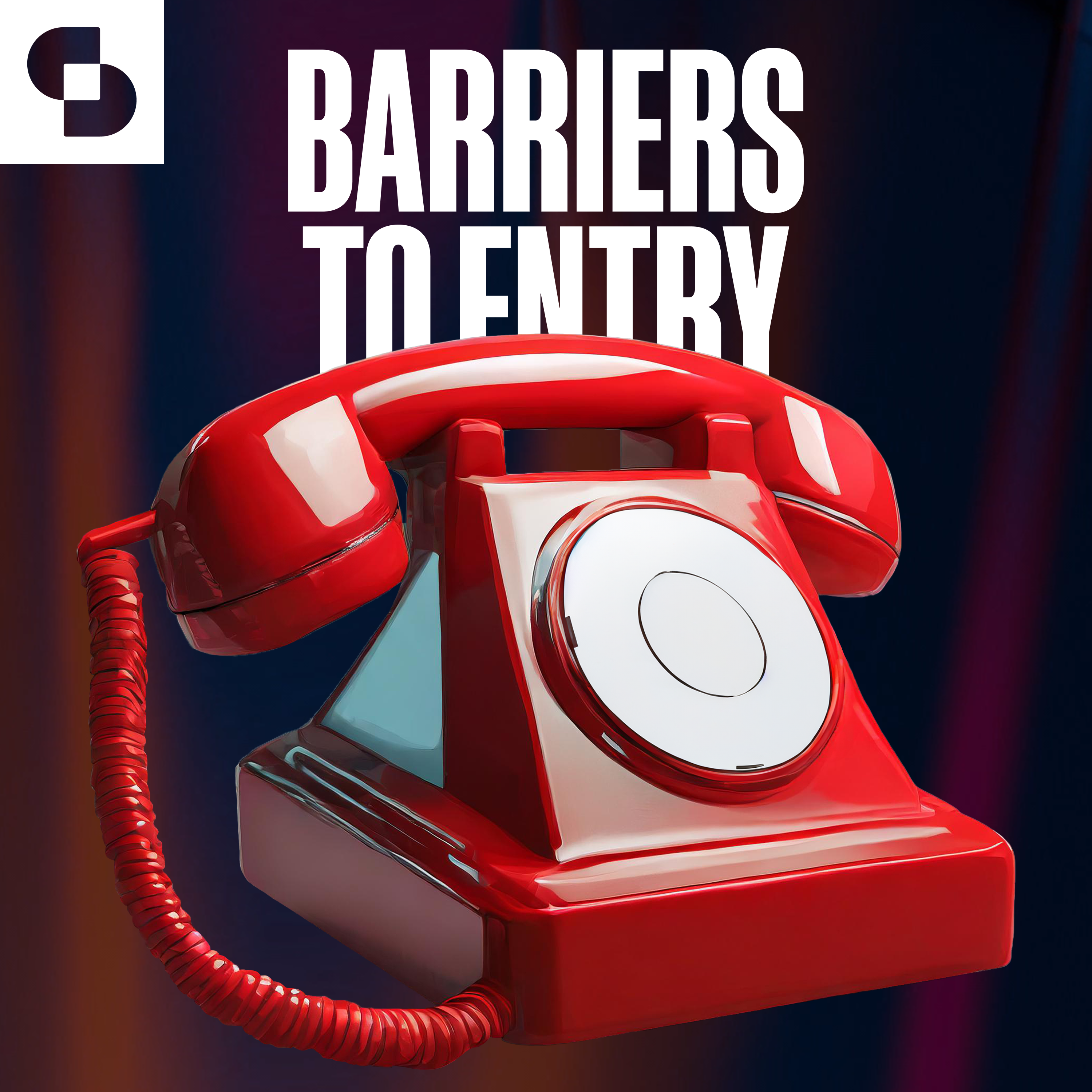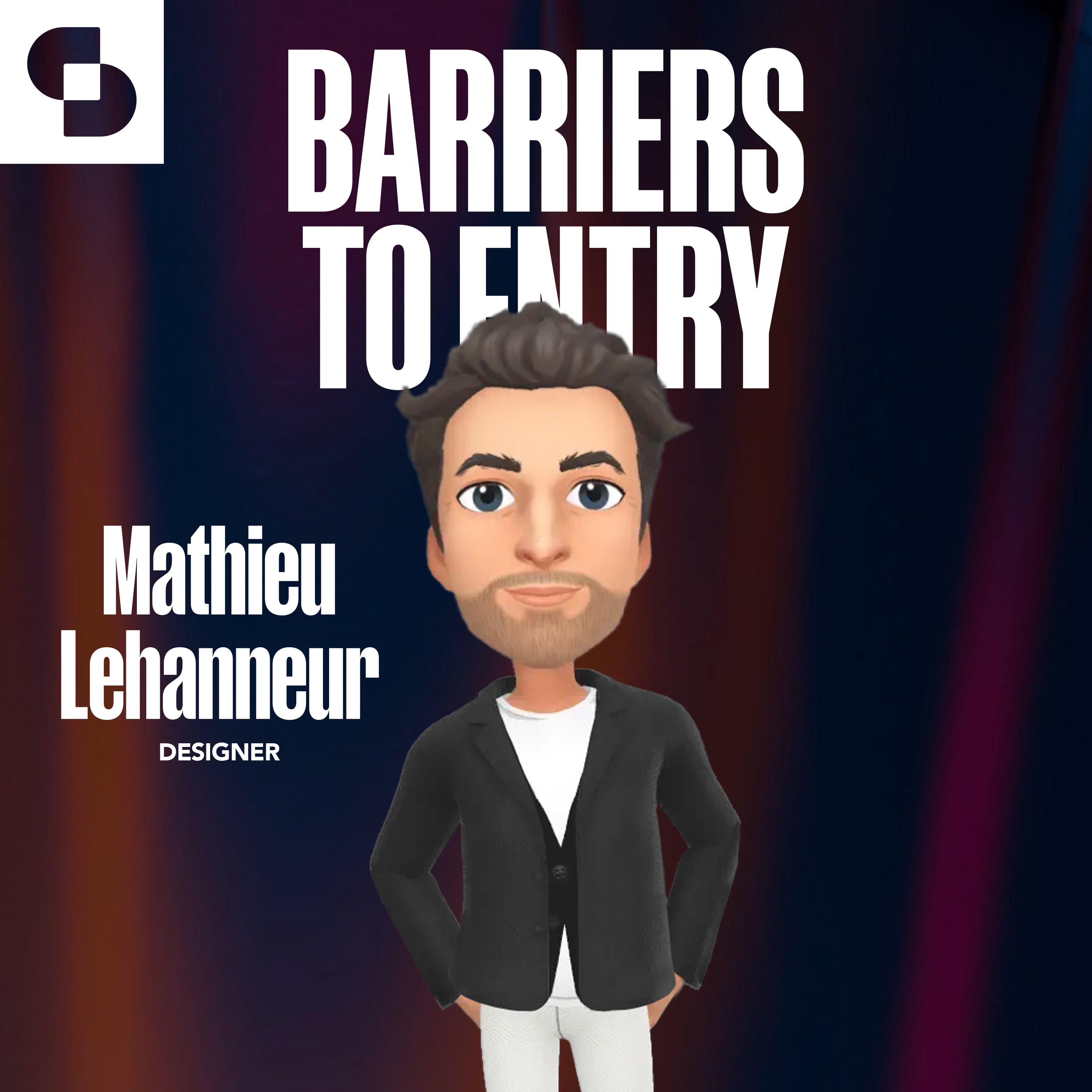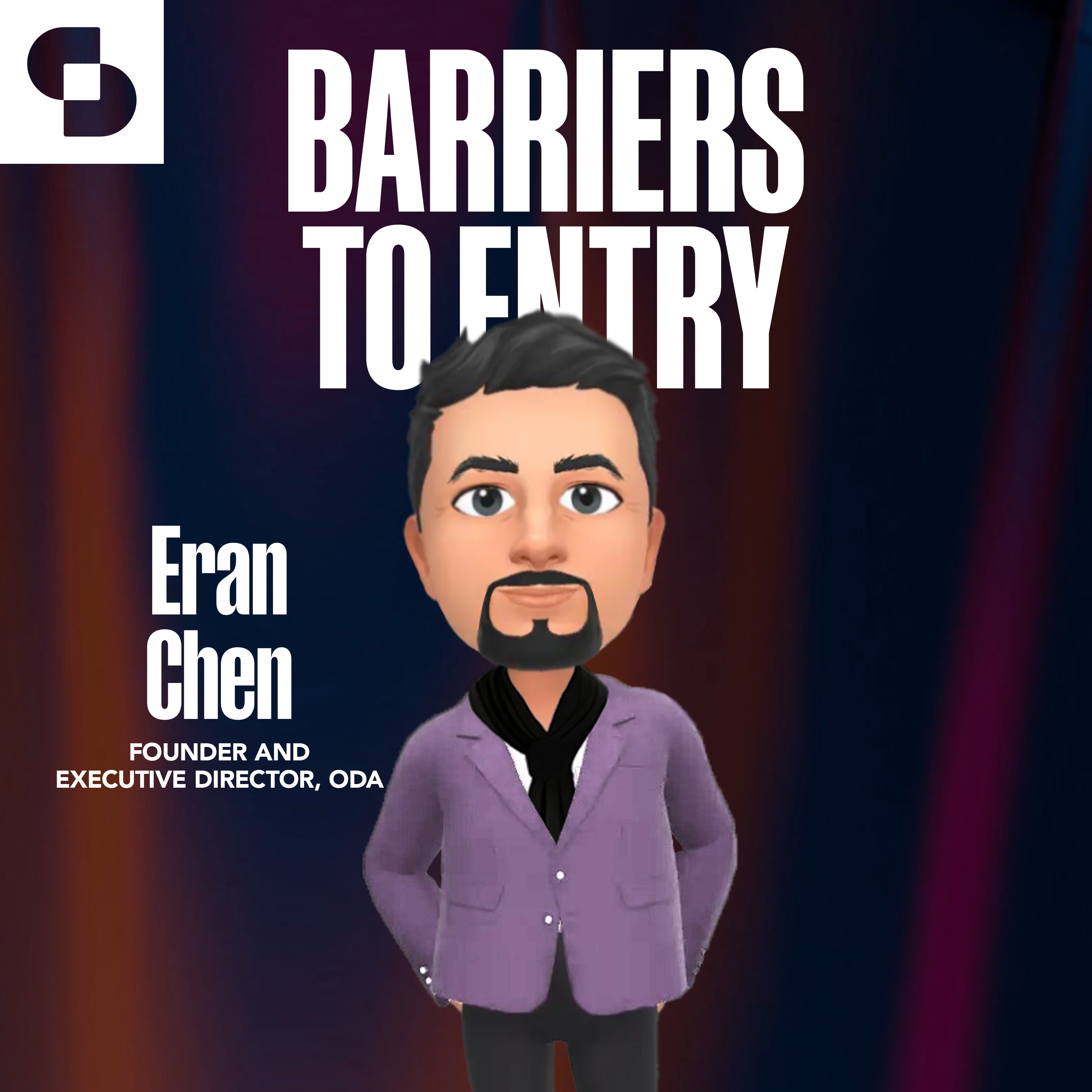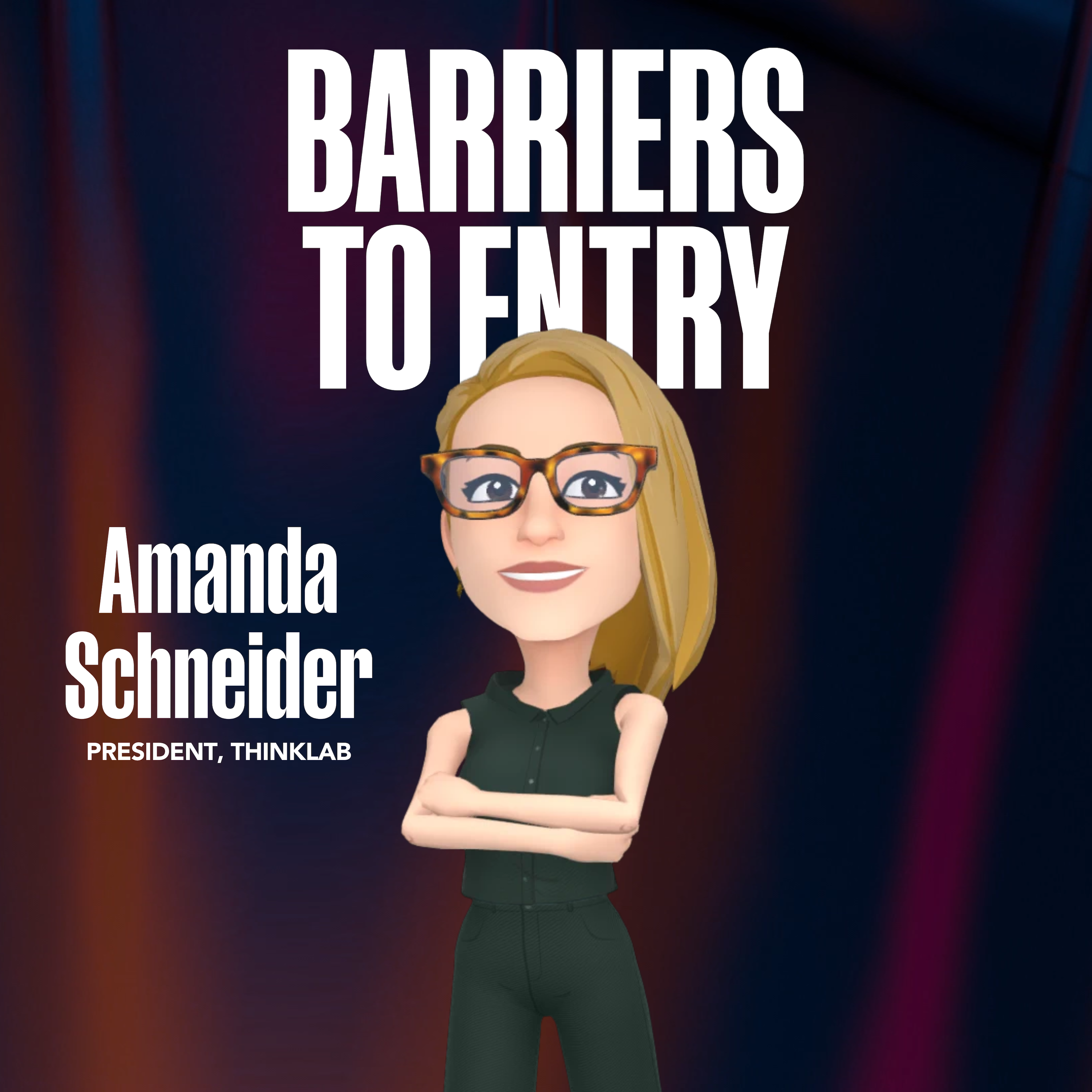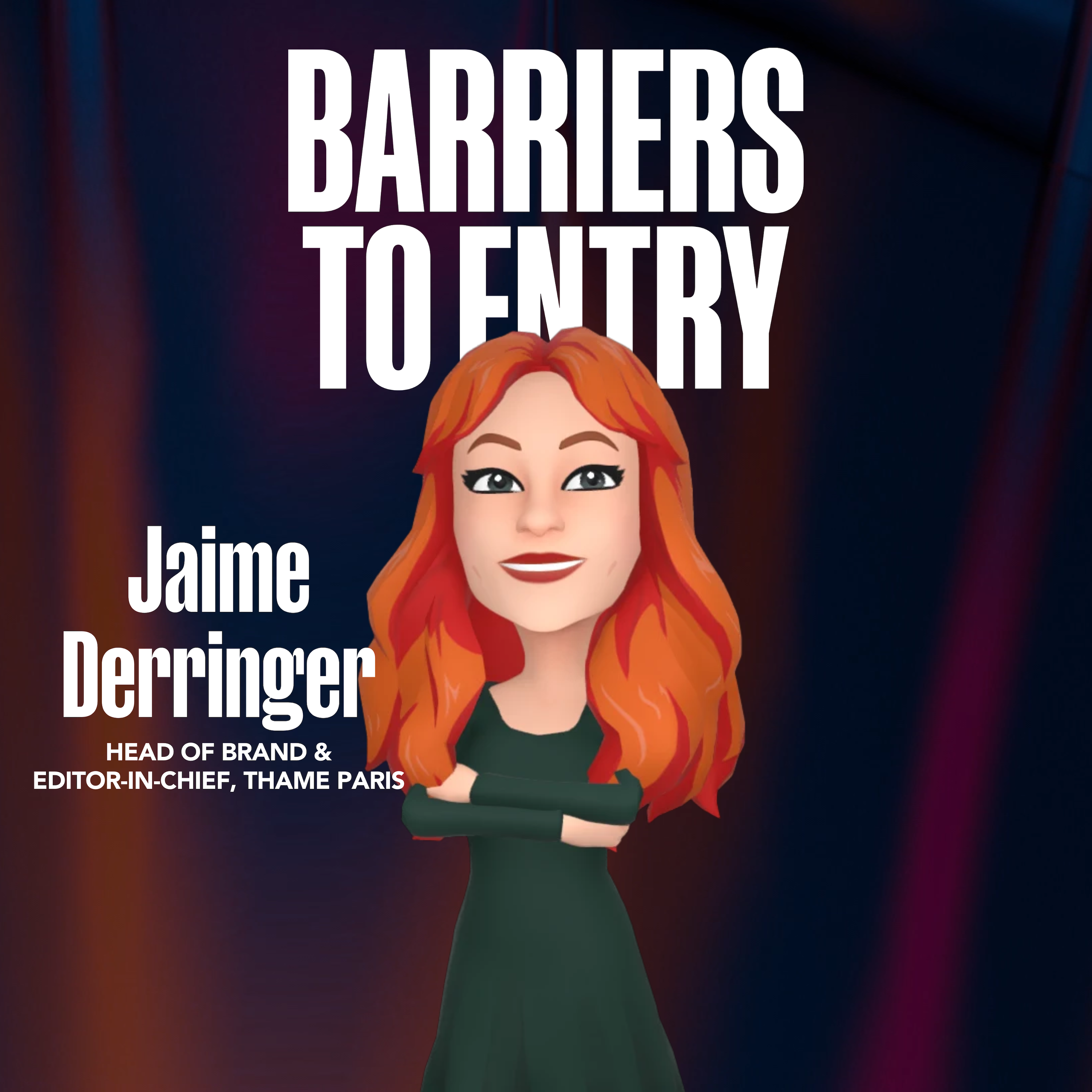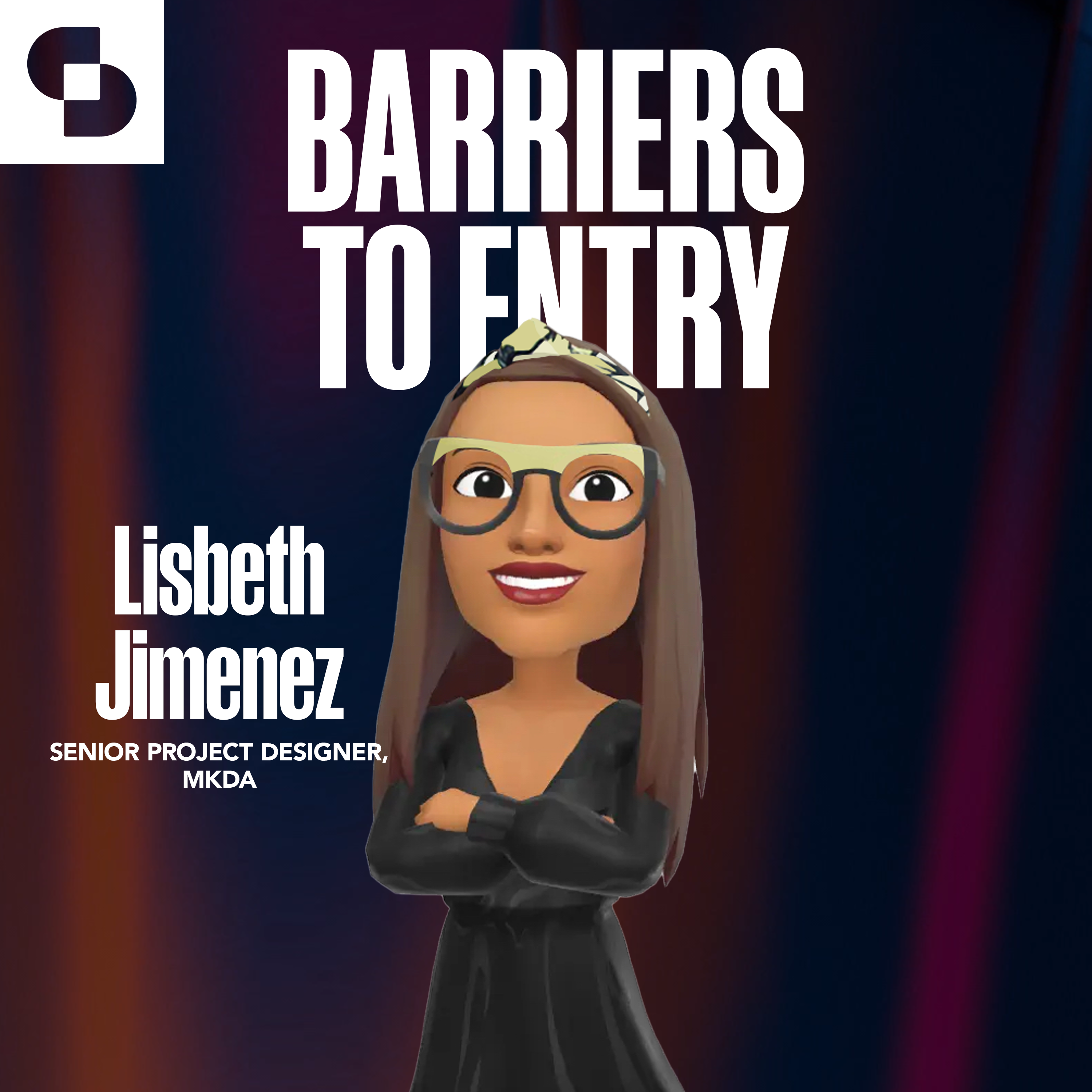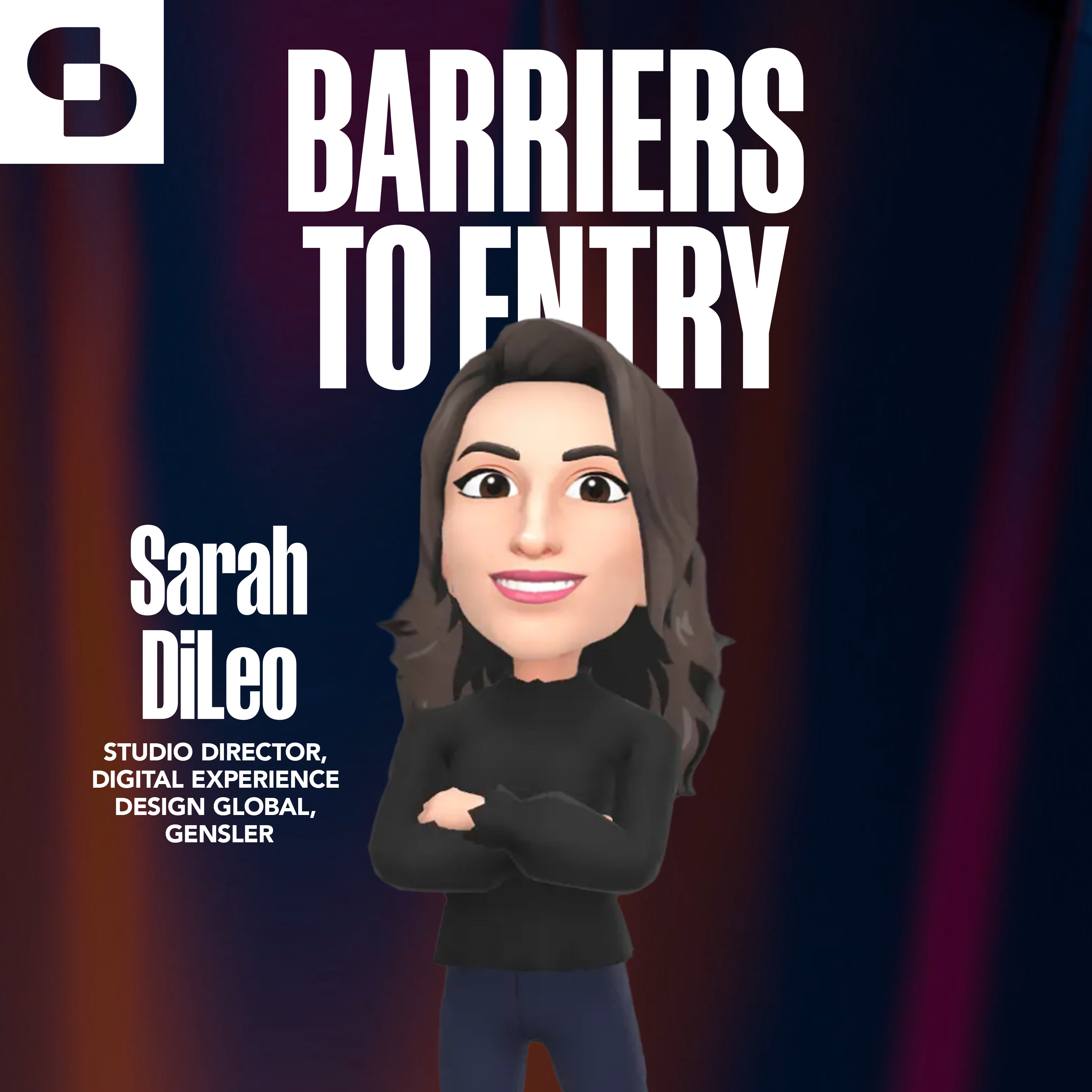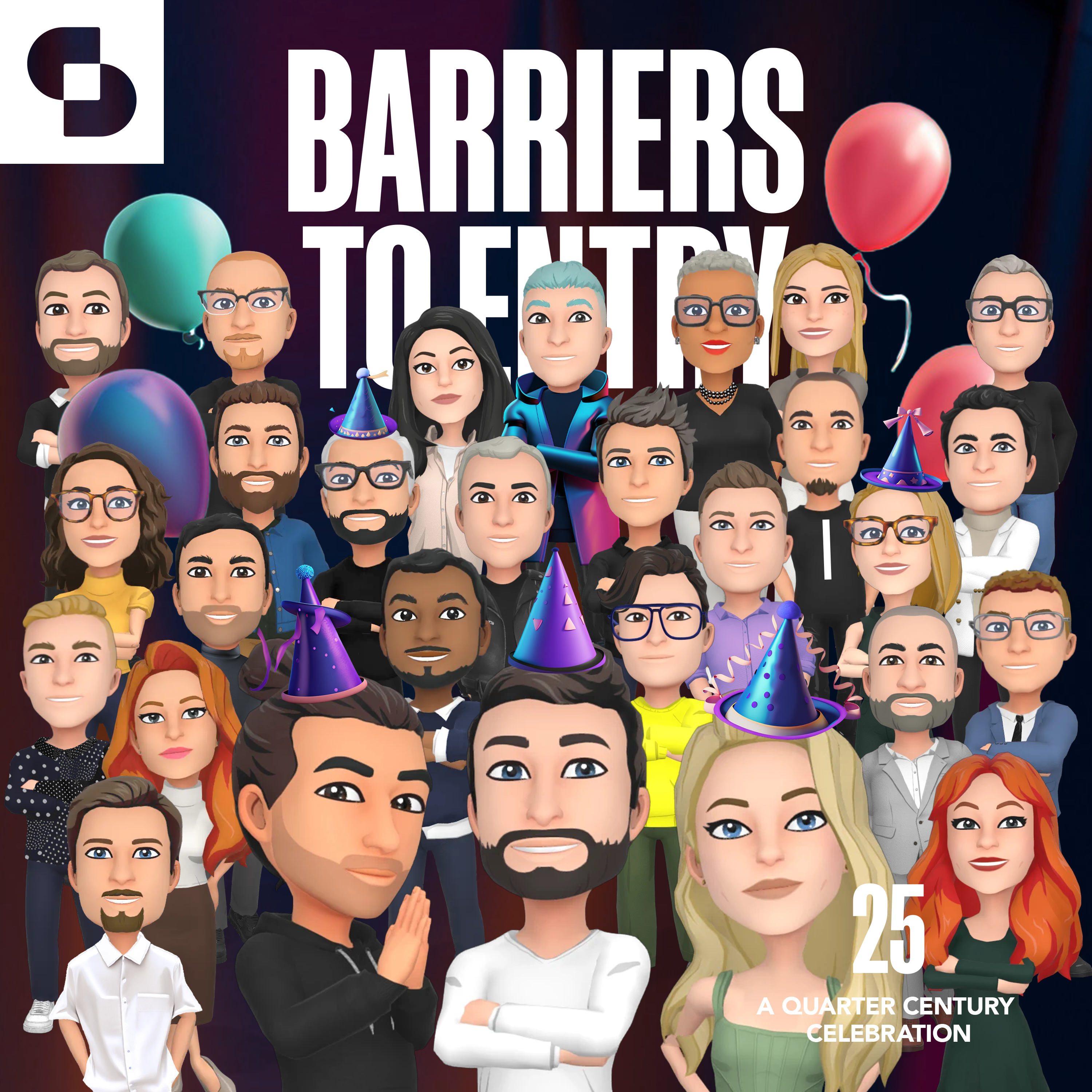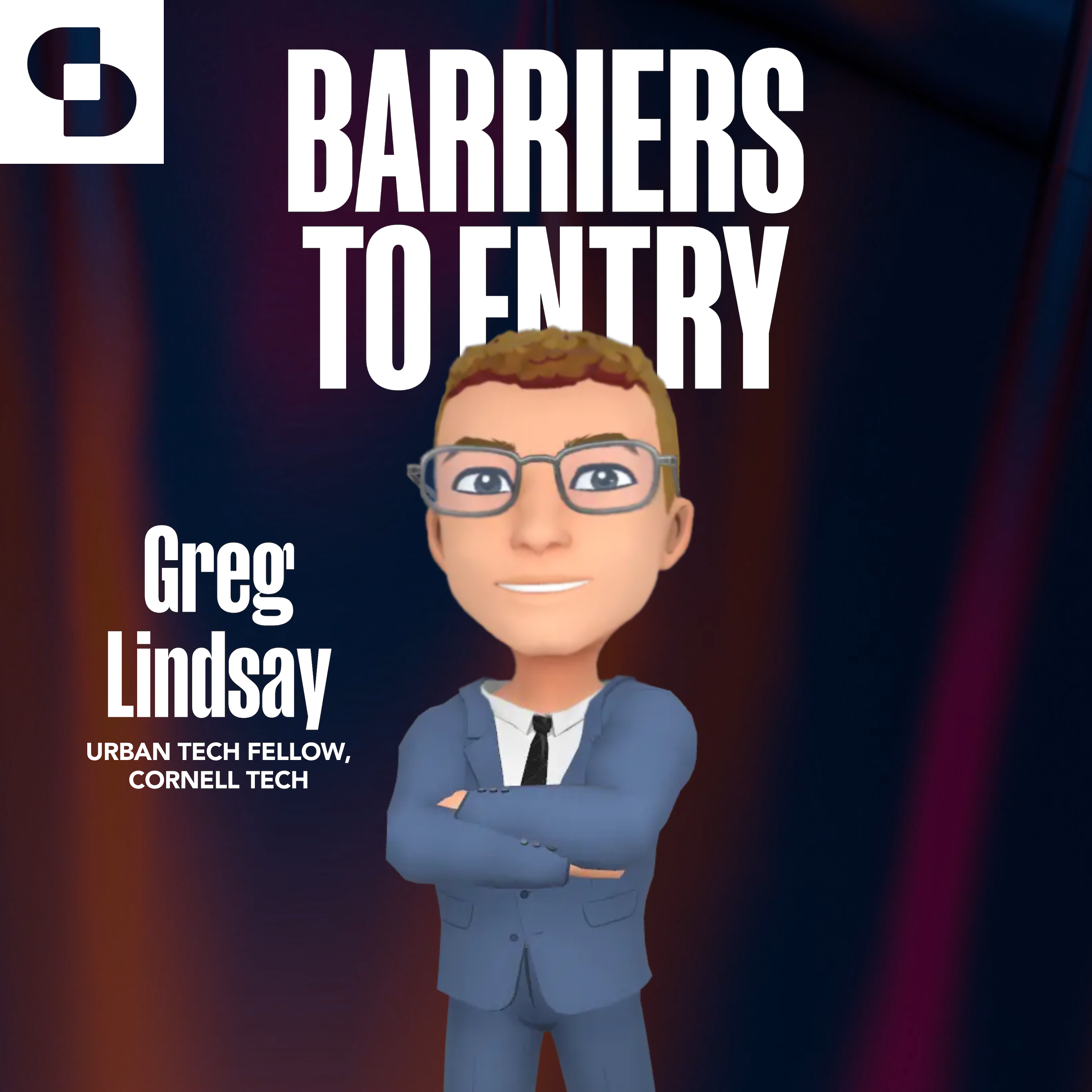This week on the pod, while Bobby is away, Tess and Andrew hold down the fort and welcome a Global powerhouse in the world of trends. Patti Carpenter, the Global Trend Ambassador for Maison et Objet, joins us for a far-reaching conversation that touches on how Metaverse and other emerging technologies are becoming trends, the pandemic’s impact on the fashion and design industries, and her work in developing countries helping to create equity and opportunity through design. A conversation you won’t want to miss!
Connect with Patti Carpenter on LinkedIn!
Moments to check out:
- How the pandemic disrupted Global trends (starts at 4:24)
- How technology is driving new trends in experiences and design (starts at 9:41)
- Artificial intelligence’s impact on the world of IP and cultural credit (starts at 16:44)
- Patti’s process to define a trend and the Metaverse as a trend vs a fad (starts at 26:53)
- Patti’s work with Aid to Artisans and Maison et Objet (starts at 40:26)
Connect with our hosts on LinkedIn;
References and resources:
Patti Carpenter / Carpenter + Co
- Maison et Objet
- TeamLab (Multi-sensory Exhibitions)
- Aid to Artisans
- Pantone
Discover more shows from SURROUND at surroundpodcasts.com.
This episode of Barriers to Entry was produced and edited by SANDOW Design Group. Special thanks to the podcast production team: Hannah Viti, Wize Grazette, Kasey Campbell Thompson, Rob Schulte, and Samantha Sager.
Although the transcription is largely accurate it was generated in part by an automated service. In some cases it is incomplete or inaccurate due to inaudible passages or transcription errors.
Patti Carpenter: [00:00:00] It is interesting to me when you talk about it from that point of view, because what I’ve also seen from a trend point of view is this idea that as AI touches different parts of what we do, is it going to be more beneficial in some areas than in others, or people want going to wanna pull back with it in some areas and.
Go further in others, and I think because we’re in this very early development stage, it is gonna be the way that it happens, but there’s a soul still missing.
Bobby Bonett: Welcome to Barriers to Entry, the podcast where every episode we get into it with the leaders, the designers, the early adopters, and the influencers who are driving innovation and the architecture and design industry.
It’s the metaverse, it’s ai, it’s blockchain, and it’s all happening here. I’m Bobby Bonnet, and as always, I’m joined by my Canadian co-host, Andrew Lane and Tessa
Andrew Lane: Bean. Hey guys. Canadian is the best compliment you could give us. I mean, it’s nice, but it’s very specific. I guess we won’t start this [00:01:00] podcast with another Canadian education moment, but we are gonna learn a lot today, which is really exciting.
I was not in the
Bobby Bonett: studio when the two of you spoke with Patty Carpenter and. I have not listened yet. So when we go away for a couple minutes, I’m gonna go ahead, hit the play button and hear the interview that y’all had. I believe in the pen one studios in New York City. Is
Andrew Lane: that right? Mm-hmm. Yeah. Vornado properties.
Exactly. But we’re really excited for this conversation with Patty. It was a great in-person sit down. Patty was even able to help Tess learn a little bit more about the vintage Ralph Lauren coach she’d Thrifted a few months before, and the story behind that. She’s a woman of many talents and a lot of knowledge.
Tessa Bain: I definitely can’t wait to speak to her again. I mean, I said leaving that podcast, it’s like, I’d love to have Patty over for dinner. I mean stories on stories. She had so many wonderful things to share with us, both from the industry, both kind of thinking outside of the box from what we’re used to. She’s a philanthropist as well.
She does so much really great work in terms of developing countries and finding those craftspeople, helping them [00:02:00] with their products, bringing those products to North America, helping create better lifestyles for the people that she works with. I mean, just to name a few of the things that she’s doing.
Theres much, much
Bobby Bonett: more. Absolutely.
Andrew Lane: Tess’s a fan. Yeah, definitely. It’s definitely easy to say and it wouldn’t be BTE if we didn’t get into it, of course, about the impact technology’s having on all of this. So let’s not belabor it anymore. Bobby, get your high speed. Listen on, we’re gonna go into the time we had with Patty Carpenter.
Tess and I are excited to be here today in person at the Surround podcast compound at Vernado Properties. Lovely Pen one in downtown Manhattan. And. Sadly, we’re without Bobby to properly plug this experience, but our producer extraordinaire, Sam Sager, is here to guide us through and we’re even more excited to be joined by a global powerhouse in the world of art, fashion, and design after successful career driving innovation in the fashion industry.
Patty Carpenter struck out on her own to help the worlds of art, fashion, and design hunt trends. Today, she’s the global trend ambassador at Maison, in addition to running her own highly successful practice where she helps businesses around the world [00:03:00] understand what’s next. And today she’s here in person with us.
Welcome
Patti Carpenter: Patty. Hi, I, it’s so nice to be here with you. This is so fun. It’s great. It’s
Andrew Lane: always fun when we are live at the Surround podcast compound here. And yeah, we’re really excited to to dive in with you. And I mentioned in the intro, you got your start working in fashion with the likes of Ralph Lauren.
What was it about your work in your first career that set you up for success in the world of trend hunting?
Patti Carpenter: That’s a really fun question. I always liked the idea because I don’t think I could do what I do exactly without those 27 years in fashion. Really, it came from a love of the making of things, the materials in which things are made, and the understanding.
I came into the world I think with an innate sense of color, and over time, even in fashion, several of my, uh, higher ups always said that I, I was able to talk about. Color. I was able to talk about trend in a way that made it tangible. A lot of those things, you know, come from creatives and you’re really kind of intangible when you try to talk about what’s inspiring you.
Mm-hmm. And the way to connect those dots was something that I [00:04:00] always had because I always had an interest in the business as well, not just the creative side. And so to be able to sort of connect those two things has always been a strength. And I think as I moved out into my own, that’s one of those things that I took with me, that ability to talk to designers.
To talk to makers and to really translate what they’re doing and feeling into a very tangible way to then express it to clients and to the community at large.
Andrew Lane: Yeah, that connector piece I think is something that’s underrated with a lot of people. Like it’s not always so easy to find the thread between two things that might appear disparate to other people, and so we’re so excited about what’s going on with this disruption in the industry right now.
Can you speak to a moment during your career that’s been as disruptive as this one? Like when, when have we seen something paradigm shifting like this before and, and kind of how did that play out? What should we be watching
Patti Carpenter: for? Well, that’s a really interesting question because I think. At the core of it, there’s not been anything this disruptive when you think about the pandemic, probably since the Spanish flu where, and even here, we, [00:05:00] what we went through was so interesting from a trend, you know, sort of research and forecasting point of view because we never had anything touch the entire world.
At the same time, in the same way previously, and because we’re so connected by way of the internet, by way of the work that we do that’s become so global where we’re very interconnected in terms of how we do things. Then once that, how was disrupted, which is what happened with the pandemic and everything, having to just stop.
We really had to rethink, rework, retool the way that we did things, and really talk about. What was important to us as humans. Mm-hmm. You know, as we moved through all of this and into what we are now, which is still sort of unstable, we don’t, we aren’t, you know, at a place that’s finite anymore. So this sensibility of moving through it, I don’t think we’ve ever had something quite as disruptive as we’ve had this time.
But what’s interesting about the disruption is the way. That people are moving through it. There’s a group that’s coming through that’s really powerful [00:06:00] and, and all about being very ens shrouded in this sense of being able to push through and to be strong. And then there’s this other group that came through it and got very quiet and very kind and very much a about the wellness and the wellbeing and about self-care.
And so there’s all these kinds of things that have come out of it that are interestingly sort of a balance of both sides of how to handle this really insane disruption.
Andrew Lane: I think I’d be more on the self-care side. Why do you think that? I, I don’t know. I’m just, you know, always about treat yourself. Right.
Well, I, yeah,
Tessa Bain: that might be the opposite of the wellness that we’re talking about
Patti Carpenter: here. Geez. There’s both, I think to that there’s taking care of yourself and there’s a range of what that means. Sometimes that means treating yourself. We saw a rise in things like spas. Mm-hmm. You know, and people going out and doing things that really took care of themselves.
Their body. And we saw this incredible shift from that into wellbeing where we’re talking about not just the body, but the body, the mind, and the spirit. And so those things have really created a trend around rituals, if you [00:07:00] will. And the way that we come home or stay home and work from home, you know what’s happening in one room might be different than what’s happening in another.
I just spoke at the National Candle Association and just the way that people are using fragrance. In their homes as a trend. It’s a very different thing than what it was before the pandemic. What are the
Tessa Bain: changes you’re seeing in
Patti Carpenter: fragrances as well? In fragrance, what we’re seeing is that there’s different ways of delivering fragrance now.
So we’re not just talking about candles, certainly incense, which was, I’m a little older than both of you, so I came through the seventies where we burned a lot of incense.
Andrew Lane: You know, I grew up Catholic, so I’m very familiar with
Patti Carpenter: incense. I had that too as an Episcopalian. Yeah. Frankincense and Mer. Mm-hmm.
But we’re definitely seeing a rise in incense. We’re seeing a rise in diffusers ways of delivering fragrance without the fire or the heat in that way. And we’re also seeing things like in the shower, Kohler just came out with this amazing thing that the scented shower. Mm-hmm. You know, are you refreshing?
Are you calming? Are you energizing? Mm-hmm. So how fragrance is used in that way has become really important. And that sensibility of, [00:08:00] in this room, I’m going to be calm in this room. I need energy in this room. I wanna meditate. In this room, I wanna just enjoy something that feels very natural, like these herbal fragrances.
And so you’re seeing a lot of that. And the last thing I’ll say is smudging, which is really interesting. Again, something that was big in the late sixties and early seventies. Now you find smudging with all kinds of fragrance in them, aromas coming through, but they’re available at like every small, beautiful, little lifestyle store.
You know, it wasn’t before. It was sort of in your hippy dippy kind of space. So
Tessa Bain: interesting. Another thing we saw at CEL too was Mooi, I don’t know if you saw this, Patty. They did the AI sent experience
Patti Carpenter: so, We see a lot of that. Yeah. A lot of technology coming together with fragrance in, I didn’t see the salon one, although I heard about it.
Mm-hmm. But in Paris I saw a new brand that was called Compose, C O M P O Z. It’s not here yet, and it’s your music. And fragrance. Oh, I love it. And so they tie in six different fragrances based on the type of music [00:09:00] that you wanna hear. So again, that music in one room might be different than the music in another.
And the fragrance that’s released, you can do it on an app. There was another brand that I can’t remember the name of, that we saw at Maison Obje that had this beautiful ceramic sort of vase that was a decor piece, but you had an app on your phone and you could change the color. Of the top part of the piece.
And with that color came a different fragrance. And on your phone it might look like sunshine or a flower or the ocean, and that’s the kind of fragrance that you were able to program to come out of that piece. Nice. So yeah, there’s all these wonderful technologies that are tying fragrance in as well. I need a fragrance
Tessa Bain: that helps me work out.
There
Patti Carpenter: you go. Yeah. It has something for energy. Yeah.
Andrew Lane: Yeah. It’s interesting as you talk about this, my head goes to thinking about 3D spatial tech and how. You know that un flattening of the internet is really about trying to create more multisensory type experiences, and that’s a lot of what you’re just describing in other areas of trend.
Can you speak about the power of something that’s multisensory? I. In that way where you’re engaging [00:10:00] just a lot of different things at
Patti Carpenter: once. Well, that’s certainly the direction. That’s absolutely the direction as the technology gets more interesting. There’s a company that I’m not sure if you’re familiar with called Team Lab.
Do you know them out of Japan? They’re amazing. They’ve done a few of those multi-sensory kinds of place of exhibitions and experiences at Maison, which is where I first met them. But they do things with real flowers that move. Based on you moving through. They do things with sound and fragrance within a space where you touch the ball and the human touch changes the color.
The color then sort of connects to all the balls that are around it, and another sound comes from the color blue, then comes from the color green that comes from the color orange and those kinds of things. I think we are going to see a lot more of, because I think they draw us in mm-hmm. As humans to really.
Connect with something. I think, again, because of what we’ve been through with the pandemic, we were so disconnected and we were really longing for that. And I think you see it [00:11:00] also as you talk about mental health, they’re tying technology into that. And as you think about young people feeling depressed or that sense of not understanding how to reconnect, When they go back into a space where they have to reconnect with others, how people are using different types of technology.
Yesterday, one of my favorite things was I went to be a judge at F I T for a capstone project and product design. Mm-hmm. And one young woman created this beautiful little chair for children from five to 12 that has this technology built into it. To bring them down in calm anxiety. Mm-hmm. And so they had, she had sound, she had motion, and she had the touch of the fabric and she had a massage component.
And I love the idea of bringing all those things together for children, you know, and so those are things that, that could be placed in a school or in a hospital or any number of places. But it’s the idea I love of young creators thinking about those kinds of things. So yeah, I think tech technology’s gonna be really important and with.
The advent of ai, to your point, you’re gonna be able to speak those [00:12:00] things. And we were actually having a wonderful conversation about the fact that so many people are pushing back against ai and I’m not sure yet where I land. I know that there’s wonderful, useful, you know, uses for it. Um, and there’s some scariness around it as well as it grows faster than we can help it grow or make it grow.
But this idea that. We’ve been using things that we didn’t even realize it. I wear glasses now. That idea that you could put on a pair of Warby Parkers and see what you look like in the glasses was technically the things we’re talking about. Mm-hmm. But people didn’t associate them at that point with it.
Now, as you talk about the other day, I did something because I knew I was gonna talk to you guys where I was working on a collection of outdoor furniture, and I spoke into it, you know, the things were tan, outdoor furniture, coral colored cushion metal frame. Mm-hmm. Chairs and table. And it made it. Mm-hmm.
And I just go, whoa, you know, now it wasn’t what I wanted. It wasn’t what I was thinking and certainly in terms of a designer, but the fact that something in, you know, [00:13:00] less than a nanosecond mm-hmm. Made me four different versions of that was kind of fascinating. Mm-hmm. Yeah. And when you
Andrew Lane: think about AI from a personal assistant type standpoint, even just some of the other experiences that you’re describing, we’ve been talking about it a lot on the personal side from the standpoint of diet.
Mm, right. Like there’s so much about gut health and things like that these days, that ais are going to be able to account for these things for us and create these like incredibly bespoke, really increasingly accurate experiences. Cuz that was you trying this out for the first time, right out of nowhere.
When you build a relationship with a tool like that, over time, it’s gonna get to know you better. It’s gonna get to know your, your own. Skills better, and obviously your biases, which is something that I think a lot of people are worried about. Right? About the technology. But I think that there’s an area where the bias can be a good thing, uh, and it can start to become a tool that can, and really help to extend an aesthetic or to improve an experience.
Mm-hmm. There’s a lot of
Patti Carpenter: possibility there. Yeah. I agree that on the one hand there is that the other side though, that’s interesting for me as a designer and as a creator, In [00:14:00] addition to working in the world of helping others to design and create is if I put that in and I’m working for a specific customer mm-hmm.
Then I have to put in all that customer information because otherwise what I might design for you might be different than what I might design for you, you know, in outdoor furniture. Mm-hmm. Where I’m using the same overarching trend as an example to drive what I’m doing, but I need it to be very specific and different.
For both of you to be able to sit in the space and speak to your own individual consumers or customers, right? So that’s the thing that I’m really interested to see, sort of where the specificity can come to your point of re understanding my bias and understanding the way that I might design something versus the way that another designer might design it, right?
It opens up a whole world.
Tessa Bain: Well, that’s the, the coolest part about it is it’s just untapped
Andrew Lane: right now. Then I think that it, to your earlier point, Patty, it’s learning so fast and there’s so many people applying themselves to it. If you look at the metrics around investment from a venture capital standpoint, mm-hmm.[00:15:00]
Everything is pouring into artificial intelligence right now, and with the potential for that is incredible.
Patti Carpenter: Absolutely. Absolutely. We just have to watch out for that whole debacle that happened with NFTs in the early days. It’s interesting to me when you talk about it from that point of view, because what I’ve also seen from a trend point of view is this idea that as AI touches different, Parts of what we do, is it going to be more beneficial in some areas than in others?
Are people want going to wanna pull back with it in some areas and go further in others? And I think because we’re in this very early development stage, it is gonna be the way that it happens. I know when we first chatted, I was talking to you about the fact that I was a little apprehensive as a creative because I feel as though, and this sounds so namby pamby or you know, we are the world, but.
There’s a soul still missing mm-hmm. In some of what can be done from a creative point of view. I feel that, and as somebody, even in fashion, as computers came into the way that TE or [00:16:00] technology, not just computers, but technology at large came into the way that we did a lot of clothing design. I can still walk into a sax.
And look at something and tell whether or not it was designed by somebody who used a computer versus somebody who drew it by hand. Mm-hmm. And people don’t believe it, but it’s really true. And I’ve proven it on more than one occasion. And it’s because there are subtleties of the way that things are done, are turned, are finished, that are the human touch to that piece.
Mm-hmm. And that’s missing when you design it on the flat. On a computer, we’re using a CAD system of some sort. And when I say the bias, when you were talking about the biases, it’s those subtleties that I think are gonna make it interesting. You know, it’s gonna be a very interesting thing to watch as it learns and gets better.
Okay, so
Tessa Bain: ai. As it impacts the creative is obviously really fascinating. It’s really cool to hear how you’re using that in your everyday work, but I’m curious as to what other impacts you’re seeing this technology make on history, on ip, and in terms of cultural credit. [00:17:00]
Patti Carpenter: Yeah, that, for me, that whole idea of cultural credit and that impact on IP is paramount in the work that we’re doing, especially from the other side of my business.
As you know, I have this branch that works with Artisan Development and under that umbrella, I travel, uh, a great deal to developing countries and we work with artisans, often indigenous artisans, and we help them to link to markets for whatever they make by hand. So a local or regional or an export market.
And one of the things that has been the most difficult for me to see is the way that the handmade is now being replicated by machine without. Any deference or acknowledgement given to the origins of it, to the provenance of it, and. The way that it’s coming through. I’ll share this one story cuz it’s the one that really moved me the most was I work in Guatemala, a great deal.
And there are different types of weaving that happen in Guatemala. So they weave by hand on a petal loom or a backstrap loom, [00:18:00] and they make the women there make pretty much all, especially the indigenous women make the textiles that they wear. So the clothing for the women is a top, that’s called a we peel and a skirt that’s called a corta.
And those are all hand woven they can take. Weeks or months, depending on where they’re, what area of the country they’re from. When I first started going, you could actually identify the women by what they were wearing in terms of where they were from in the country and. Those, those traditions have been handed down of how you weave them, how you embroider them, how you dye the yarns before they’re woven to create certain patterning, which then identifies where you’re from, whether it’s woven on the back, strapp, which gives you one type of fabric and a wider fabric than a, than, um, sorry, a narrower fabric than on a pedal loom, which would give you a wider fabric and usually a flatter fabric and.
They started being replicated in China, and as they’ve been replicated in China, then they’re less expensive. Mm-hmm. And these are poor rural people who don’t have a lot of [00:19:00] money. And so the women at this, in this one village, which was outside of Antigua, just probably a year or two before C O V I D when I was there, were buying the replicas.
Mm-hmm. And the replicas, because they’re cheaper. Mm-hmm. And they don’t have a lot of money. But what it did was it made less and less available. Of the hand woven cuz they weren’t weaving and it made the hand wovens more expensive because now there were less of them. And what I see with something like that, or the same type of thing that I might see in Africa where young men or women don’t want to learn to weave or die or throw ceramics or carve wood like their grandparents or their parents before them because they see them making a dollar a day.
They want to go into town and do something that they feel like they can make more money at. We’re going. Those kinds of things are layering one upon the other, and they’re going to cause us to lose some of this in a generation. And for me, that’s heartbreaking. I really enjoy. The luxuries and the things that technology bring [00:20:00] to our lives.
The ease, the seamlessness with which a lot of it is part of our lives. But on the other side, I’ve always been, just as I was talking about color, where I’m interested or the work of design, where I’m interested in the design itself and the business. There’s a balance between those two, and I think there’s a balance between us having that craftsmanship, those handmade things in the world, as well as those things that have been developed by technology.
And that’s the impact that I’m seeing. That one is encroaching on the other and in a way that I worry will squash it, and that’s what I don’t wanna see happen. How do
Tessa Bain: you share that insight and that experience here in North America with a lot of the manufacturers that do kind of focus in on more higher
Patti Carpenter: volume?
I have been having that conversation for the last 27 years. It’s part of why I left Ralph Lauren when I did, where I left the world of manufactured fashion. Uh, when I did to start my business and I started with Artisan, develop it. It’s part of why we do the training. We really talk about the providence, we talk about the connectedness to those people.
They’re [00:21:00] not. Disconnected from us. And I think certainly what I’ve seen, again, as a, as something that’s an outcome from the pandemic, we want as humans to have some of that connection in our lives. It’s a warmth that it brings to our spaces with the pieces that are coming in from there. And it’s, uh, this sensibility of being connected to the rest of the world.
You know, certainly for a while that term global citizen was being thrown around. Mm-hmm. And it’s that sense of really being a true global citizen. And I see, you know, sort of the, the Gen Z, the now the Alphas and the Gen X is certainly, are big driver of this. There are looking for more of that. And I think that they will help to spur that and move that along.
But I certainly think it’s our responsibility as, as well as those in, in, you know, What they call the first world countries to, to pay attention to that. I’m certainly a mouthpiece for it. I talk about it all the time. It’s really, really important to me and I think it needs to be important to all of us.
And so, and then also on the other side when [00:22:00] something. Is inspired by, uh, something that comes from a historical place. Make a nod to that ex. Mm-hmm. You know, that place. Say where it comes from. Say what that connection is. Because that also, I think we have a tendency to only go to the first paragraph on Google to learn about something.
Mm-hmm. And this gives us that foundation, that history about how something as simple as fashion. You know, that’s so pervasive in our lives. It’s, I don’t know what, what it is now, many years ago was the third or fourth largest business in the, in the world, you know, the fashion business. So if we’re gonna deal in something like that, understand the history, understand you know what you’re wearing and where the first time that showed up is from.
And for me, I always talk about, When you go far enough back, and I have things in my home, which my friends call a museum, but I collect everywhere I go. And I have, you know, an ink pot as an example that’s a couple hundred years old, made out of a piece of bamboo with carving on it from China, um, that, you know, was used for calligraphy [00:23:00] that I bought in, in a old market.
And routinely people look at it and think it’s African. Why? Because those two things at that timeframe, far enough back. Humans only had certain tools. Mm-hmm. We used our hands in certain ways. And think the, there’s a lot of connection between what those te, those textures look like, what those carvings look like, what the materials were, because that’s what we had.
And so then when you look that far back, you really see how connected we were. And I love that point, that idea of that’s where I wanna be with that place where we’re more connected than we’re disconnected. You’ve
Andrew Lane: talked a lot about connectedness and, and the humanity in all of this and mm-hmm. You know, ideally some of this technology is meant to help us be more connected, but I think there’s a certain level of pessimism that it’s disconnecting us even further.
Mm-hmm. Like, can you talk about this intersection between the importance of connectedness to even allow trends to happen? Like if we’re not. If we’re not all on the same page right. In a certain way and we don’t have cultural or, you know, human [00:24:00] norms that we’re sharing. Right. It’s really hard for something to emerge as as a trend.
Right. Do you think that the technology that we’re seeing in AI is at odds with some of that sort of natural human emergence of things that we collectively love and, and aspire
Patti Carpenter: to? That’s a great question, and I hadn’t thought about it from that point of view. My, my gut reaction is yes, but I never go completely with my gut.
I always then have to do, you know, then I go, why? And I start to sort of, sort of deciphering it. It’s the, that’s the trend person in me. I think that there certainly are trends that are developing because of ai. We have one called meeting in the Metaverse where we talked about mm-hmm. You know, seamless technology being used in our spaces and.
Color that’s informed by video game, you know, kinds of brights and the way that surface textures were, were kind of engaging and evocative of those kinds of things where whether it’s highly lacquered on something that’s hard or very dull and matte on something that’s really voluminous because those kinds of things kind of [00:25:00] grow out of the look of what comes out of video games as an example.
So there is a, there, there are definitely tendencies that we see that AI will will help. To drive forward in trend and sort of as I was saying before, there’s a point in a counterpoint always. So that counterpoint is that sensibility of going backwards and being very in involved in heritage and craftsmanship and even these unearthed sort of textures we call the.
The erosion explosion, that sensibility of people really liking the look of, of seeing the firing and the handmade texture and things on, on materials. So metals that look like that, ceramics, that look like that. Even textures, uh, in material in, in textile that look degraded and mm-hmm. And, and eroded in terms of how it’s woven or how it’s died.
Uh, so there is this, But I think a point and counterpoint, if you talk about it, where you’re going to see certainly that driving forward of tendencies coming from the AI world and the [00:26:00] technology world, and you’re going to see. Hopefully that an equal amount of that driving forward from the craftsmanship, going back in time to when people knew how to be beautiful stonemasons and incredible wood carvers and incredible textile weavers and, you know, ceramic throwers and, and fires.
And you see a lot of that in galleries now. And I think that, that for me, I always love art. We talked about the idea of my being part of, you know, part of my tendency work is in the art world and that sensibility that artists tend to be. Thinking about things a little more deeply than the rest of us, and maybe looking at them from a different perspective than the rest of us.
Sometimes on purpose and sometimes just because they’re deeper thinkers around someone one point. But I think that a lot of what we’re seeing even coming through in art is going to be one of my big trends is always now has art involved in it in some way, shape, or form, because I think that really drives a lot forward.
It
Andrew Lane: seems like it’s a good moment to take a half step back and define what is a trend, and you have kind of your own [00:27:00] patented approach, um, to how you identify these things. Maybe you could talk to us. A little bit, uh, for us amateur trend hunters out there about kind of where to, where to get started and thinking about this and
Patti Carpenter: understanding it.
Okay. We coined a phrase or an acronym several years ago to help our clients sort of understand, because of course, as trend forecasters, trend researchers, you used to get asked a lot. You know, do you have a crystal ball? Or you, you know, how are you understanding how to decipher this? And so we really wanted to come up with something.
Again, I like the tangible explanation for the intangible. So we coined, spent, um, the word. Trend in general means the direction in which things will tend to move. Mm-hmm. So what are we looking for in terms of understanding or trying to make sense of how things are moving? So we look at the S in spent, which is social.
What’s going on socially around us? How are we as humans being impacted by what we see socially? The P is political and certainly right now, certainly in the United States, but all over the world. You know, if you think about the impact of Russia and the war on the Ukraine and how that. You know, [00:28:00] had its domino kind of effect across the world.
Political kinds of things really do impact us and and it’s impacting all of us. They’re in Japan right now, you know, at the G seven talking about how they’re going to deal with that, and those are world leaders, so that’s impacting the entire world. Then we have the E, which we talk about, which is economic, what’s happening economically?
Certainly here we’re dealing with the idea of inflation recession, what’s that going to do to our economy? And then the N is for nature. We found that certainly to have a huge growth spurt during Covid because we couldn’t move around in the same way. So many people got out into nature as their escape after having been indoors and doing everything they had to do with themselves and their children and their sometimes very many tiered family members that were all living together.
So that whole idea of getting out into nature has. Spawned this whole, you know, use of, of the outdoor space around us, or outdoor space near us, or even outdoor space farther from us. There was a rise in people going to national parks, you know, during that time, which continues, you know, so many Americans [00:29:00] are going to national parks still in terms of what, right, what they’re doing.
And then last but not least, that tea for technology, which we’ve been talking about mostly. So that’s why when we’re looking at. This acronym have spent, there’s a rise and fall in how important different letters are at different times. Right? And then of course, that’s just the top level. So something like social would drive down into music or pop culture or art, you know, and so you, you know, that’s, that’s the top level.
Then there’s all these things that affect the drive down. Where
Tessa Bain: do you think we are now? I would’ve spent like
Patti Carpenter: the top, the top. Well certainly right now, technology is, is certainly top of mind. Mm-hmm. I think technology, um, e col the, well, the hard part is, it’s hard to say as I was about to say that. It’s actually hard to say because every time I started to say one letter, then something that’s happening in another letter Yeah, sure.
Came quote. Yeah. So as I was gonna say, maybe the social was a little bit down, but we really are having huge social conversations as we talk about how the, our country just. You know, uh, title 42 just finished. Yeah. And so we’ve got, I live in New York City, how we have this incredible [00:30:00] influx of people that are coming in.
That’s gonna be a huge social impact. And then when you talk about political, we just talked to other G seven. Mm-hmm. It’s, it’s kind of hard. They’re kind of all vying for we’re one and two, we’re in a very
Tessa Bain: heavy spent time
Patti Carpenter: right now. We are, we are very spent. We are
Tessa Bain: spent, I’d say so. Yeah. Well, one of the hallmarks of your work is being able to discern what’s a trend and what’s just a fad.
And so, you know, kind of coming back to the metaverse, a lot of people are calling it a fad. Mm-hmm. But you’re beginning to see it as an emerging trend. Can you speak a little bit about how you’ve been following this topic and
Patti Carpenter: seen it evolve? Yeah, no, absolutely. It was something initially when I’ve, when things were just getting started, that I can’t say I looked at it so much as a fad, as a trend that was only going to impact a particular segment.
Of our customer, you know, customer base. But now certainly I recognize and understand over time. Over several years of sort of paying attention to this, that it’s definitely going to impact all of us. And so it’s just it to what degree and how we [00:31:00] allow it to impact us and whether we engage in it in a different way, in different ways.
I just got my first N F T for being part of the octopus movement, which is a, a group of people that are non-linear thinkers. And when you become a founding member, you get an N F T. I haven’t even looked at it. I have no idea what it means exactly. It’s not on your mantle yet. It’s not on my, it’s not in your museum.
I don’t have it yet, but it’s the principle that even by not trying mm-hmm. You know, I ended up with something that’s very much connected to this. So I think it’s going to come at each of us, uh, in different ways. And there’s certainly gonna be segments of the population, especially as I said, I think the Gen Z, the Alphas, certainly Gen Z was, I guess, our first real digital native co, you know, group of people.
So it’s gonna start there and then move down in terms of who’s gonna be so engaged because, They do everything on, on, you know, in some way, shape, or form digitally anyway, whether they’re on a phone, whether they’re on a computer, whether they’re on a screen of some sort. And so even paying attention to this game that just mm-hmm.
You know, is starting to, everybody’s starting to [00:32:00] talk about Zelda, you know, it’s like, Okay. You know, it’s something like, okay, now I need to do this, you know, but I think that it’s going to engage with that group of people first, and by just the way that life moves, they impact what happens above them. So millennials and the boomers who where I sit, are gonna be involved in it because they are.
Um, and so I think we are in this place now where it’s going to be and just how we determine we are going to implement it in our own daily lives. Is going to be what makes it more or less of a trend in certain areas. But it’s going, it’s not a tr it’s actually, I have to even take it back. It’s not a trend, it’s a staple.
It’s going to be here. Mm-hmm. It’s one, it’s a category that we are going to always have to pay attention to. Mm-hmm. And that’s happened with lots of things. Even as I talk about the artisan work I’m doing and the crafts. I started this 27 years ago, I had to explain to my first client who bought the first thing that I made with a group of women in Bolivia.
Bloomingdale’s, what Alpaca [00:33:00] was. Mm-hmm. You know, it’s not a llama, it’s not a goat, it’s its own animal. Mm-hmm. It’s alpaca. Well, now there’s alpaca and so many things very popular, but yeah. But initially I had to educate. So it’s that same idea of on this one side where there are. Those craftspeople and creatives, that’s going to continue to be there.
It will be a certain sector, I mean, as we talk about it now, time. Handcrafted things are really part of what people are calling luxury. Mm-hmm. You know, and those things will continue to be, even as you talk about something like succession, you know, where they were talking about the quiet luxury. Mm-hmm.
Of what they wore. You didn’t see any of them. And these are the uber wealthy in the world. Emblazoned with a logo, not a single logo. Mm-hmm. And yet we at a certain level, consider luxury when you’re emblazoned with a logo. Mm-hmm. Right? Yeah. And so it’s the difference between how things are going to impact the different sectors.
They’re both gonna be [00:34:00] impacted. It’s how, and so that’s when it stops for me being a trend and becomes a staple. And then you just watch the movement within it again, the thing, the direction in which then things tend to move.
Andrew Lane: Absolutely. Absolutely. We’re. Uh, talking a lot about the digital world here, but we really talk a lot with our clients and on the pod about the increasing intersection between digital and physical.
Mm. In terms of spaces and places. Mm-hmm. And how we’re, you know, enjoying them. So we’re in person here right today for the pod, but we often do these pods virtually. There are these game-like spaces that people are spending more time in. There are Zoom calls. Um, obviously we have an interface through our phone, but we’re, I think it’s really interesting seeing.
Things like billboards and like, you know, digital experiences that now surround us in our everyday life that are becoming increasingly three dimensional and immersive. Yes. Yes. Um, can you speak about how that is sort of inter intersecting with the general trend and how that’s changing the way in which we kind of perceive our interactions with the world [00:35:00] around us?
Patti Carpenter: Oh yeah. And it’s interesting because I was, I was just listening to something the other day where they were talking about Pantone. It was really more of a panel discussion that you listened in on. They were really talking about emotion, and I think that that’s one of the things I. That’s really important as we talk about how it’s going to connect to us.
It’s, you know, a lot of it right now is kind of entertainment, you know, especially when you look at those billboards where it looks like the tiger is coming out and, you know, swooping down at you and things like that. That’s kind of entertainment, but what it is doing is tapping into our emotions and giving us a connected, a connectedness again to our, to that brand.
Around however that’s making us feel. Mm-hmm. And so this whole idea, you know, that that particular talk was talking about color and emotion and how you bring those things together in a brand and how you tell brand stories, which are definitely going to become increasingly more technology driven. And you know, you’re gonna try clothes on.
Without trying clothes on, because people may or may not be worried about going back to the [00:36:00] store or sharing, you know, a space where other people have been or trying something on that other people have tried on. There’s all these conversations about how it’s going to impact fashion in that way, but it’s also this whole idea of just.
Who, who are you? What’s your DNA as a brand, and who is your customer? And how are you making that connection? Because we are really sort of voicing our values a great deal as customers now in terms of how we’re shopping. So you’re gonna look for those brands that connect with you and connect with you emotionally.
So the way that technology’s going to be used is to connect in a more emotional way to the people that they’re trying to bring in. And that emotional connection is going to keep the customer longer, and it’s also going to foster that conversation between you and I about something that you had a great experience with.
So it’s gonna be a lot about the customer talking C to C about their experience with something and then that driving the sale. Or the engagement for the next person as well. And those kinds of connections are happening through [00:37:00] technology. But technology now paying attention to who we are and trying to tap into us from an emotional point of view.
Really
Tessa Bain: fascinating and not at all a sponsored example. It should be, um, and I don’t know Patty if you’ve ever seen this, but Muto, so I used to work with Muto back in the day and they actually did an installation and I, it’s gotta be about four or five years ago now. Okay. And they had people wear smart bands walkthrough spaces, and in each room was a different color experience and a different tactile experience.
And of course it’s furniture, so, The installations were different in the space and they tracked the heart rate. Mm-hmm. And I’m not sure if they tracked even like, I’m not sure what it’s called, like the sweat it was skin. Yeah. Mm-hmm. Yeah. Or, or mm-hmm. Yeah. Any kind of, uh, the skin contact. But what was your experience as you walked through and experienced the brand and immersed yourself in that space?
I love that. I don’t know why this is the first time I’ve thought about this, because that was a great sales tool to kind of speak about the brand and color and the way that Muo really approached design. But it’s a perfect example of talking about the ways that we can think [00:38:00] about the, I guess, Intersection between digital and physical spaces.
Patti Carpenter: Absolutely. There’s, what is that Art house down on 17th Street where you Pantone did the release of the color of the year? Mm-hmm. Through this totally sensory and surrounded mm-hmm. Experience. You moved through these different rooms and it was the year that it was the blue, which I’m not remembering the name, sorry, but, You had water in one room, you had air in another, you had blue stones and all kinds of things.
But they did this immersive experience around experiencing that color being brought inside almost to that color. Mm-hmm. And that was how they launched it to the world in terms of talking about the color of the year. And I’ve been on a couple of these kinds of places that you’re talking about where you walk into a room and have an experience.
And I think it’s also the same thing that makes these exhibitions like the Van Gogh, Yeah, experience where you walk inside the paintings, right? Mm-hmm. All these things happening. The first one I did was in Paris probably six or eight years ago, and they had clamped. And then they had two very [00:39:00] modern digital artists.
So in one, in one room, it was very much sort of stepping back in time with these paint and inside the paintings of Klimt. And then in these other two rooms were very digital with things running on the walls, almost looking like the matrix and all this kind of stuff. Mm-hmm. And you and the way that they did it, you had it.
Which I really loved. We didn’t do this here in New York, I don’t know why, but they had it all around you. So the floor, the ceilings and every wall had it. Whereas here, you, your, the floor didn’t have it. Mm-hmm. And so you kind of were brought out of the experience because you could look down and not be in it.
Whereas there you were surrounded and it was fascinating. And so that’s why I say I really don’t think it’s, it’s a trend in that way. It’s really gonna be a standardized way that we find brands interacting. With us as consumers, it’s just, you know, which of those tax are they gonna take and what can they embrace that will tell their story the best.
You know, when I think about it from the point of view of architecture, you can now speak, you know, into, uh, a chat G B T kind of thing and describe a building. And [00:40:00] it will draw it, you know, and create it for you. And so are we gonna see it being used that way as buildings get developed, you know? Mm-hmm.
You can draw in the air certainly with certain kinds of pens and create things and you can, you can mix and match and play together, whether with the in real life and the metaverse kind of feelings and AI kinds of things. So yeah, I think we’re gonna see a lot more of that. And as long as it’s touching our emotions, we’re humans.
That’s gonna be the thing that draws us in. Yeah. The
Andrew Lane: multisensory and the mixed reality. It’s, there’s a lot of, of really interesting pieces converging. Yeah. I’d love to hear a little bit more about your work in international development. Mm-hmm. Um, and maybe you can just tell the audience what got you involved and what it is that you’re hoping to accomplish in the coming years.
Patti Carpenter: Well, uh, I got involved 27 years ago with an organization called Aid to Artisans. I’m still working with them and they were the first organization to really train. Artisans. And so what I do when I go in country is often I drop in. I am connected [00:41:00] to groups. Sometimes it’s smaller groups, sometimes it’s entire communities of people that are working in.
Whatever. So within a community, I could be working with just weavers or just ceramicists or just woodworkers, or there could be everything within a community, and it could be men and women. It’s predominantly women that I tend to work with, probably about 85, 90%. And our goal is to help them to understand just how to do what they’re doing.
Better so that it brings economic and cultural sustainability to that region. So what we might do is, is help them to understand better finishing on their weaving so that the fabric has the ability to be used in different ways. Um, rarely are we using or finding a use that is bigger than what they are doing.
That’s the same. So I’ll use as an example. When I was talking about the women in Bolivia and the throes, I worked on a project for three years where we helped them to finish it better, to do better quality control. So the sizing was standard. [00:42:00] Each of the women in this community could make a different kind of macrame border.
So if they wanted to do an order, we wanted them to pick one or two of those borders and everyone learn it and standardize it so that when somebody ordered it, they knew what they were getting. And it’s. Actually, that sort of thing was counterintuitive, if you will, to how they might usually work because the reason they all had a different one was because they were working in a local market and they sell it to carry the baby, to carry the groceries in.
You know, the Highlands above Bolivia and the mountains, you have the entire four seasons happen in one day in the morning and the evening it’s freezing, and in the day you move from spring to summer at the height of the day and then back down again. So they were using it as an on again, off again for the way that they were moving through their day as an example.
We used it as a throw. They don’t know what a throw is. What are they throwing? You know, everything is functional in these communities. And so it’s this idea of an of, of helping them to understand you can make exactly what you make, but if you make it just a little bit better, meaning the [00:43:00] finishing of the yarn is better, or the standardization of the size and the macrame is better, you now can sell 600 of them to Bloomingdale’s.
Right for a whole lot more than you’re gonna sell one or two at the local market. And so that’s sort of the basis of what I do in terms of going, in, understanding what they make. I’m not trying to change what they make in a big way. And I’ve had a lot of pushback people talk about while you’re changing their culture.
But if you think about it, culture is a fluid thing. We all. Are a product of the impact of the different things that we’ve been exposed to on us. Mm-hmm. And so if they’ve had no exposure, if they’ve only been doing the same thing over and over and over for hundreds or thousands of years, then they’re only gonna make the same thing as soon as someone comes in and goes.
That could be slightly different. If it was a different scale, if it was a different color, if it was a different finish. And you might have a broader market for it, and that market might clean your water, might send your kids to school, might make you have better housing, you know, might help you to buy more, more and better materials for planting because the second largest, uh, source of income [00:44:00] for indigenous people.
Is their craft. The first is agriculture. Mm-hmm. And the second is craft. And so if we can help them to make a better living with the craft, then that’s really what we’re about doing. So I’ve just finished a project with the Philippine, the government of the Philippines, where we work with 17 different manufacturers to help them to understand what they’re making.
Some of them generations old. Uh, do it. Understand what they’re making, what they have, the CAPA capability and capacity to make, and then how we might identify for some of them, some alternative markets, meaning coming here to the US or going to Europe and participating in trade shows and having a broader market for what they make.
So that’s really sort of at the base. So that’s one I’ve just finished. I just got back from Vietnam about six weeks ago. We may be doing a similar thing in Vietnam. I went to a furniture fair there. Mm-hmm. That I’d never heard of. It’s a huge fair vifa. There’s, um, 2,400 exhibitors and about 20,000 people from around the world that move through in three days.
So it’s a very good size. Fair. It’s 14 years old, so we’re talking about that same kind of training. [00:45:00] I have a couple of partners I work with in this training where they do a lot of the business development around it, cuz costing and pricing and packing and shipping and understanding rules and regulations and duties and quotas around materials.
You know, that you’re trying to bring into other places needs to be learned as well. So we train all around all of that. We train around how to participate in trade shows. So I’m working on that training. Uh, the I C F show is coming up on Sunday here in New York, which is the International Contemporary Furniture Fair.
I’ve got some clients coming in that I’m gonna walk. This show with one is a brand new lighting company called Lights and Lamps out of London. Two wonderful young people who have been doing private label for a while of designing lighting and they over the pandemic decided they wanted to start their own brand.
So they’re trying to come into the US so they’re gonna walk this show as we are recommending that. Maybe that’s a show they might wanna. Do. So those are some of what I’m working on. And then I just got home, as I was telling you from the Candle, national Candle Association Conference, which was fascinating.
I love that. It’s about the fourth time I’ve spoken, but there I learn all about, you know, the wicks [00:46:00] and the wax and the technical things about burn time. But, so that’s the technical side. But then I come in and talk about what’s happening in color, what’s happening within the rooms that these particular fragrance pieces might sit within.
So they can have some sense of how they can, you know, grow and, and, and change as well. Mm-hmm.
Tessa Bain: And we also know you’ve been the Global Train ambassador for Maison Maison, but I just wanna nail Maison O
Patti Carpenter: Mazo. Maison, which is House A, that’s, people kind of go through it, but the A is in there, the et, that’s and, and then oea, which is Object Home.
And Object. Maison o. We really just wanted to learn how to pronounce
Andrew Lane: it, I think.
Patti Carpenter: Yeah, yeah, yeah. Thank you
Tessa Bain: for coming in. We’ve achieved that goal, but we want you to speak a little bit about the work you do there and the impact you helped
Patti Carpenter: make. I love that work. As I said, 10 years now, doing it and being their global trend ambassador basically means that I go to the show twice a year.
It happens in January and September in Paris. Just outside of Paris, actually in September. It happens in tandem [00:47:00] with Paris Design Week, and in January it happens in tandem with Deco Off, which is a lovely textile show. What it is is eight halls of just incredible product. It’s about 65,000 people that come through there in five days from all over the world, about half French and the rest International.
We have thousands of brands that come from all over with about five or 600 new brands each edition. And so what I do is I. My job is to get into every one of the eight halls to ascertain the overarching things that are coming out of the products that I’m finding there. And then what I do is I bring all of that back and I disseminate it down through my funnel.
And I look at it the way that I think designers and and other creatives who need that trend information are needing it. So we talk about the color that we see emerging or refreshing or declining. We talk about the palettes, the way color is being used together, because that’s really also as you work in.
Product design, you need to understand how you’re gonna color something. We talk about the [00:48:00] materials, what are things being made in, where are the changes and shifts that we see happening there? And then also what print pattern and surface design is emerging. And what I find often is, certainly there’s very few things that are.
Are happening exclusively, but there definitely are things that are much more European than than what happens here in the us. There’s also tiers of clients and customers, so they’re early adapters, and then there’s those that drive through that need to see it a few times before they’re engaging in it.
And so when I talk about trends, I also have to be very mindful of the audience. Am I talking to people who are going to be at a mass level? Am I talking to people are going to be at a luxury level and what are the differences in terms of how things are going to play out? And my favorite analogy for that is if any of you’ve ever seen the Devil wear Prada.
I think I was telling you all this when we talked before too. Mm-hmm. Where the Meryl Streep character talks about that ceru and blue and how it came down the runway two or three years later. Then before. She fished it out of some sail bin at Target, you know? And that’s really what it is. It’s [00:49:00] it things start, you know, and they’re in the zeitgeist at a top level, and they drive through in different ways.
And every trend is not for everybody, of course. Mm-hmm. And the way that it’s interpreted is different, you know? So as it moves through, it gets interpreted differently. So things like texture, we’ve been starting to see a great deal again. We were apart from each other. Now we wanna touch everything, you know?
Mm-hmm. So we see these. High piles and lots of bouquet continuing loops and things. We see warmth in color, the direction of the warm colors, all the terracottas, the brown being the new neutral over the gray corals and things like that really coming through. So that whole warm side of the palette, oranges, yellows being very important.
And then on the other side, greens are sort of the color that continues and every level of green. So you know, the herbal, uh, what we call the herbal, uh, and essential greens. Continue to be important though, really the color of the herbs that you grew during. Mm-hmm. During pandemic all the way through to the maites and the emeralds and those really rich, earthy forest greens.
And then on that whole AI side, we see this, you know, [00:50:00] this influence of color, which is nearly neon, very. Bright, very acidic. Mm-hmm. So if you talk about even just the color green, how yellow it got. Mm-hmm. As it got more acidic, you know, so you start to see all of these shifts happen. And so that’s what what, so with Maison, I go, I look at all of this, I put it through the funnel, I create presentations, a general one, and then specific one.
So they do have a fragrance section. So one is specific to fragrance or rugs or lighting or whatever I might be working on with a client. And we talk about how are we gonna take those things and what impact, if any, does it have on what you’re making. Love it.
Tessa Bain: So Patty, we always love to end our episodes by asking our guests about a piece of advice that you would share, or resources that you can tell us about to share
Patti Carpenter: with our audience, a piece of advice and resources in terms of resources.
For those of you who are sort of interested in what’s going on in the trend world, I certainly think Pantone is a great way to start their wonderful organization, their global organization. So you get a lot of information about color. I also tell people, [00:51:00] especially because I’m focused in the home, And the gift in the fragrance areas.
So from the poem side, I, I mean I still have fashion as part of it cuz fashion kind of feeds through everything. But I tell people to look at things like all the paint companies have colors of the year. Mm-hmm. They’re never the same. Although I think a year and two years ago. Not last year, but the previous year all of them had a green, which was the first time ever.
Mm. Which was very interesting. And why I say I think green is just one of those foundation colors. It’s going to continue. And so I’d encourage ’em looking places like Benjamin Moore, Sherwin Williams, or Bear, and just looking at the color cards that they put out every year and looking at what they’re calling out as a color of the year.
Because if you think about what they’re saying, paint’s gonna be as an example. You can start to think about what. Might populate the space, you know? Mm-hmm. If it’s going to be this range of colors. So those are kinds of places that I tell people to kind of start in terms of just working with color and understanding color and getting comfortable with color.
And then from the point of view of advice, it’s very hard because we’re talking to a broad audience. So it’s like, you know, [00:52:00] for me, I was talking to students yesterday at F I T for their thesis, as I was telling you earlier about the chair and um, I think that it’s very important, especially now to ground yourself away from.
All the impacts of social media and all the rest of it in many ways just to, to come to an understanding of who you are before you go out into that world and to sort of center yourself as certainly you’re in the world of working around doing things that really are interesting to you, that you have some sort of passion and connection.
I’m that person that loves that word connect. And I am a connector because I think it stops being work when you do that. And that’s what I found by, you know, when, which you talked about a big disruption. The big disruption in my life was leaving 27 years of fashion and striking out on my own right. And I did that because of what I was interested in.
And that was the work with the Artisan development first. And it was really interesting because as I’d done this about. 10 years I was cleaning out something and I, I don’t do it nearly as much as I used to, but I used to keep journals constantly [00:53:00] and I was looking through an old box of journals from when I was a teenager.
And what I had written in my journal was, I want to work with the artists of the world. And that’s basically what I’m doing now. And it brings me tremendous joy. It’s tremendously hard work and I’m on the road all the time and I am exhausted a lot. But it’s the stuff you love that makes you push through and just keep doing it.
And so I think. For me, I know a lot of young people wanna go out and have their own company, and I think that’s wonderful. They wanna be entrepreneurs. I think that’s wonderful. I am one, but there’s a certain fortitude that one needs to be an entrepreneur. Mm-hmm. And there’s also a certain level of knowledge and skill, and so go out and work with other people, learn how they do it, and discern what works best for you.
I worked in so many companies over my 27 years in fashion. I saw. People doing many of the same things, cuz you gotta go through the same pipeline basically to mm-hmm. From concept to the customer on, you know, the customer and the floor of the store. But how they did it was different. Mm-hmm. And I learned from them which [00:54:00] one I liked best, or the way that I liked the, to do something better than another way.
And you can learn that. On someone else’s dime. You know, if you come out and at least do a little bit of work with people and then strike out on your own. So that sense of passion and all that is wonderful, but it’s not all you need. So I think in terms of talking about it from that point of view, that might be a bit of advice.
That’s
Andrew Lane: amazing. Mm-hmm. More than just trends. We really appreciate all the advice, all the, all the thoughts. And of course, just really diving into what we’re seeing emerging in the world right now. There’s so many fascinating things happening in this moment of great disruption. So, We were so fortunate to get to chat with you about it today, and we wish you all the best with your international development work as well, which just sounds so fascinating and and rewarding.
But we can’t thank you enough for joining us
Patti Carpenter: today. Oh, thank you guys for having me. This is great fun. Lots to chat about and you gave me some things to think about.
Andrew Lane: I love that. Always, always our goal. Always our goal here. Thanks so much, Patty. Thank you, Patty.
Bobby Bonett: First off, if I may, Andrew and Tess. Great job
Andrew Lane: on the [00:55:00] interview.
Thanks, Bobby. That means a lot. That means a lot. Yeah. You held it up. You
Bobby Bonett: held it together. Star of the show though, Patty Carpenter Tess. Mm-hmm. As you mentioned in the introduction, a wealth of knowledge brings with her to the studio. Just a fantastic amount of experience, and then inspiring as well, pulling from that fashion background.
Obviously a trend setter and a trend spotter now in the architecture and design industry. Then circling the wagons, if you will, from a future looking and from that futurist perspective as well. Perfect fit for the Barriers to Entry alumni program. Andrew is my feeling walking away after listening to
Andrew Lane: that episode.
Yeah, absolutely. Absolutely. And I mean, I think one of the things that really strikes you is the way in which Patty’s really created a process. Um, Around understanding what makes something a trend and how that really integrates. And I think that’s really what allows her to be so knowledgeable and it’s such a resource to such a broad range of industries, even well beyond architecture and design, and even with getting into color and all of these other areas in which she does her work and where she excels.
And I
Tessa Bain: haven’t stopped thinking about room sense. I mean, just that little, the [00:56:00] nuance that you can create with a algorithm based. Room sense. You know, just even her insight on that as a trend from Maison and OJ was really
Andrew Lane: fascinating. Yeah, absolutely. There’s was so much to unpack and I, I’m glad that everyone who’s stuck around to this point, I hope you all enjoyed the conversation as much as we do.
And Bobby, you know, one thing that we failed to mention in the outro here, and one of the reasons that I think Tess and I thrive so much is because we were actually joined in the studio that day by none other than Sam Sager podcast producer extraordinaire, and it seems like an important moment to thank her as well as the rest of our production team.
Wise and Hannah, chief researcher Casey, as always, Rob Schulte, and just reminding everyone that Baris entry is a production of the studio by Sandow and a part of the Surround podcast network. And you just heard a recording live from the surround podcast network studios at Vernado Properties. So make sure that if you liked it, you go to surround podcast.com.
That’s podcast with an S, smash, tap, touch. Press down on the follow button so that you can get the next great episode, and of course, join us next time as we continue to [00:57:00] break down the barriers to entry. Emergency
Bobby Bonett: plug July 26th. Patty Carpenter will be at the Perspectives Conference in New York City at Penn one in conversation with Amy Devers.
So if you wanna see Patty Live, you know where to find Bobby Bonnet.

